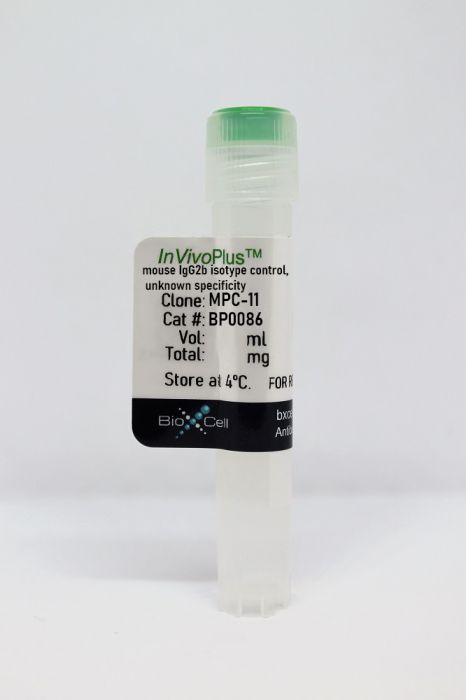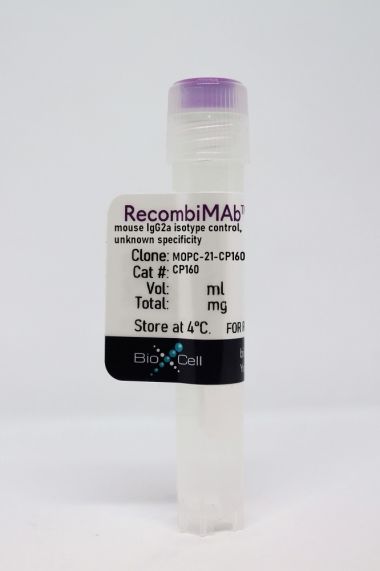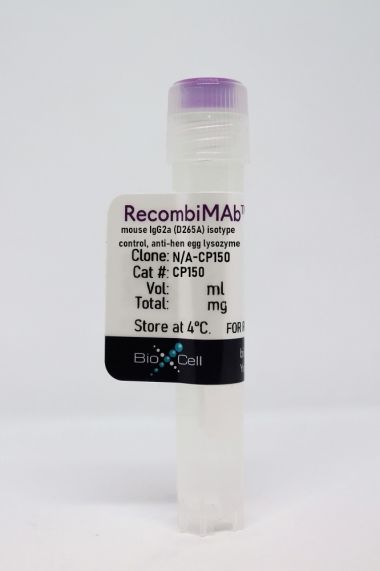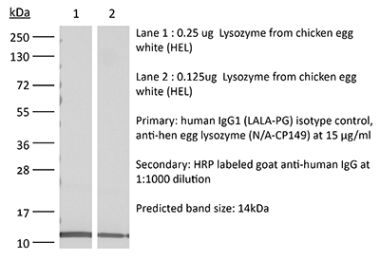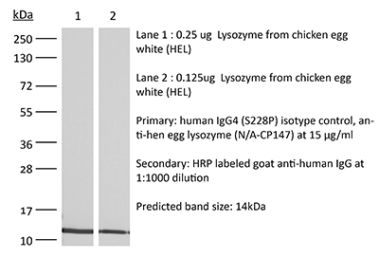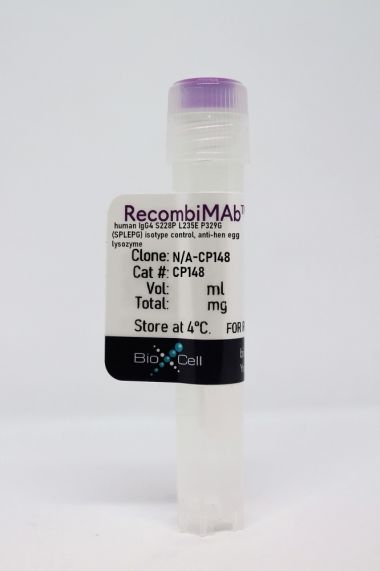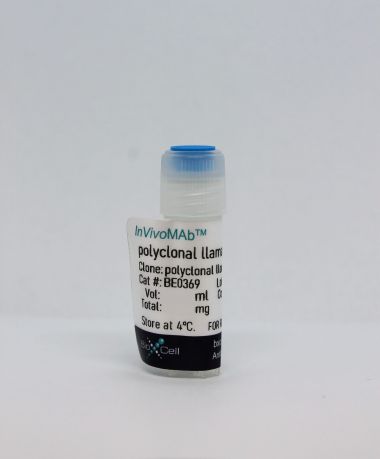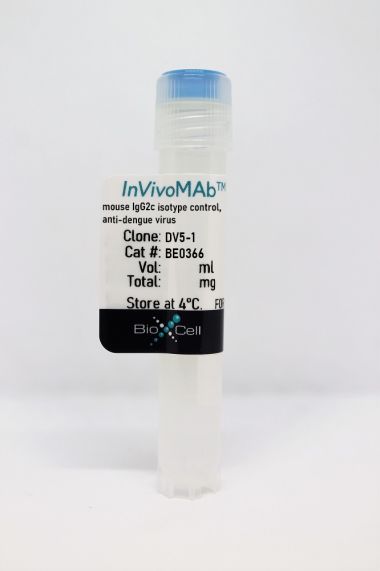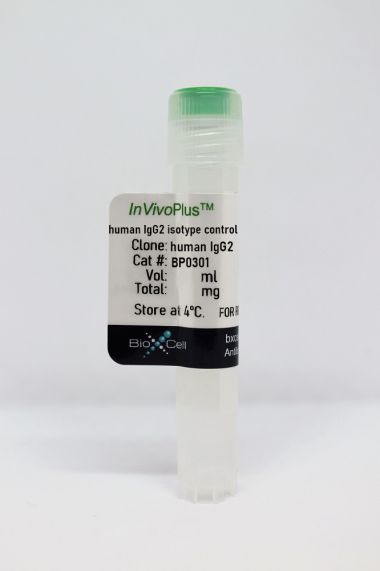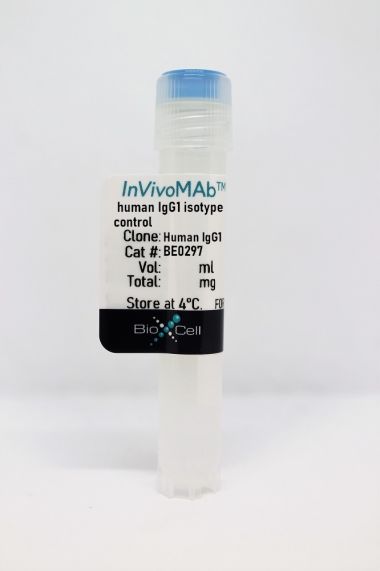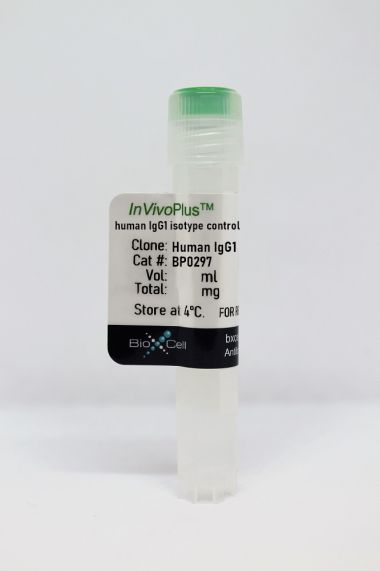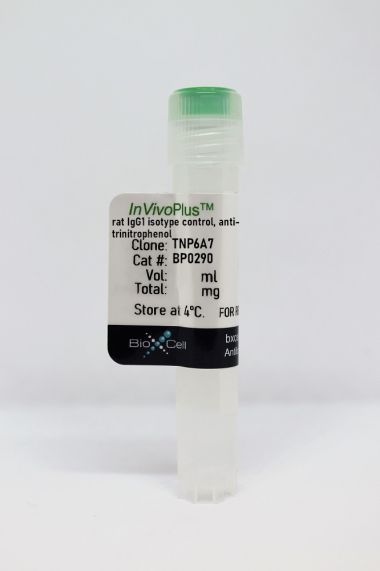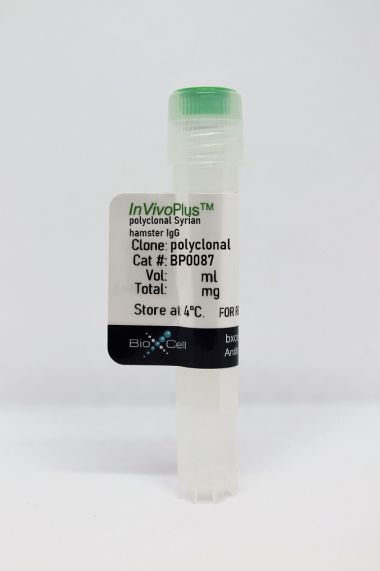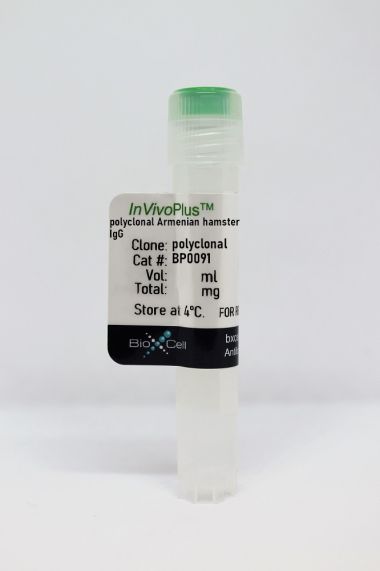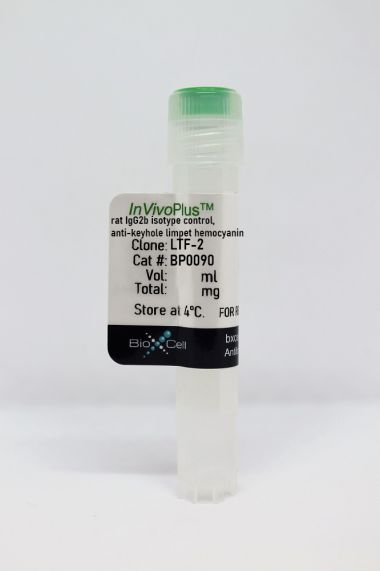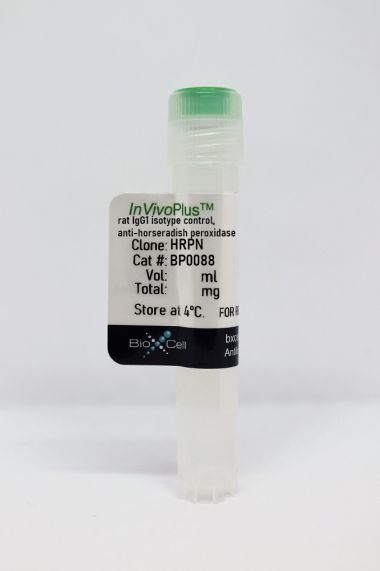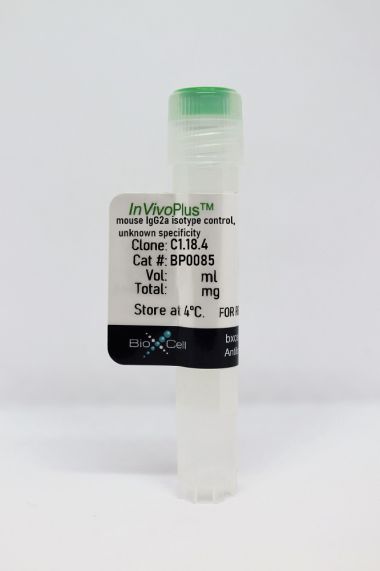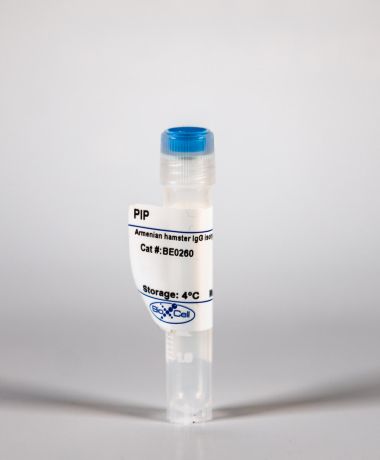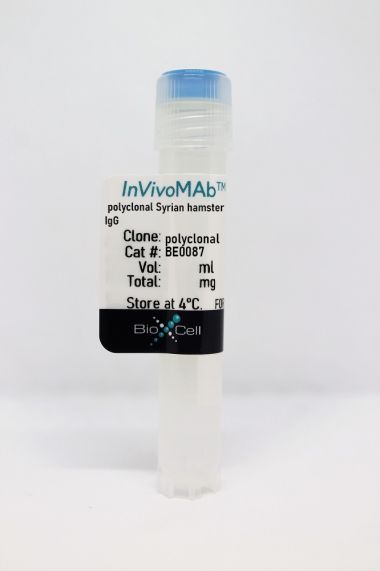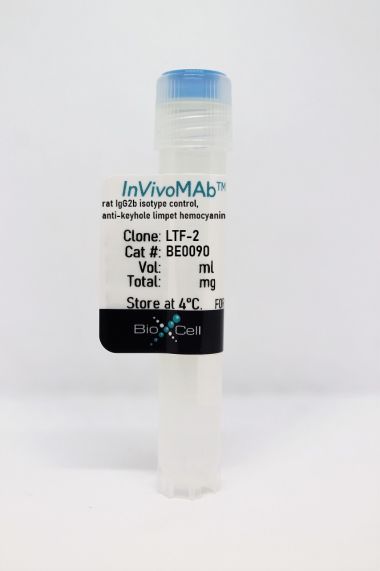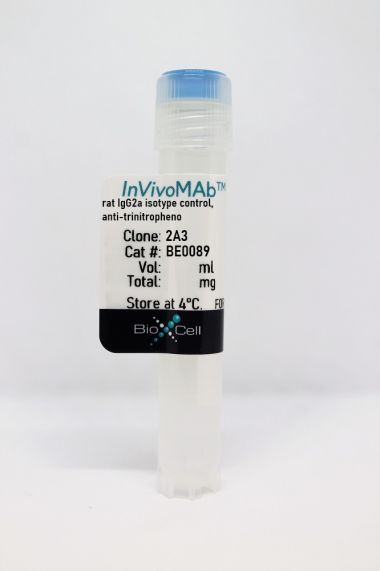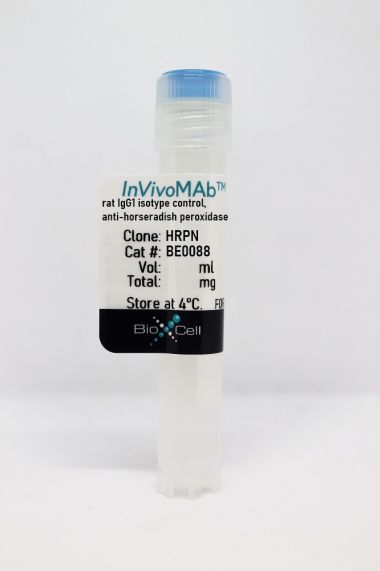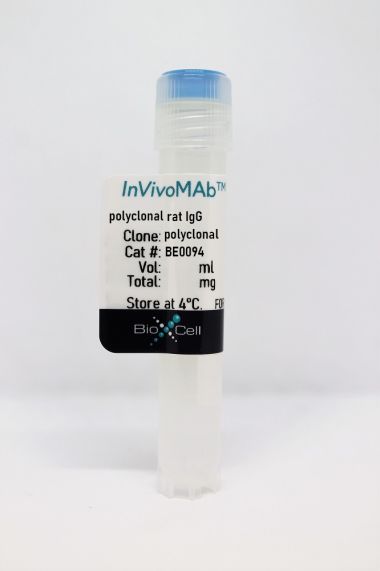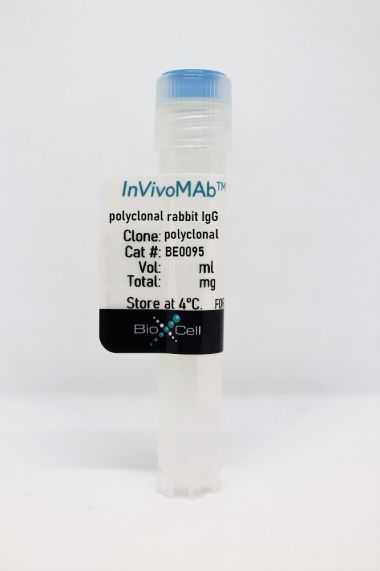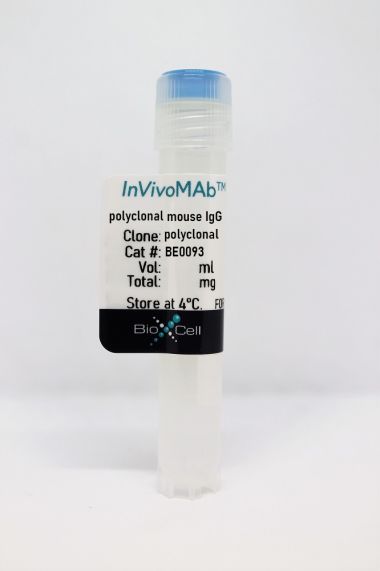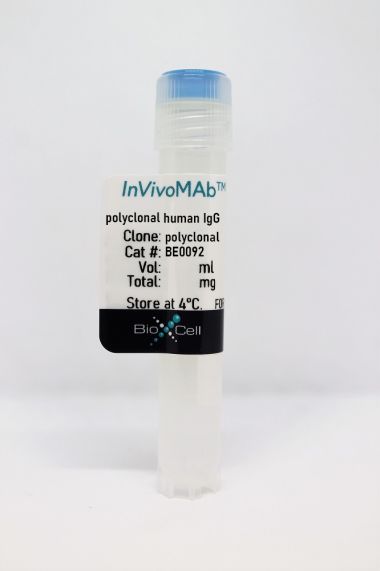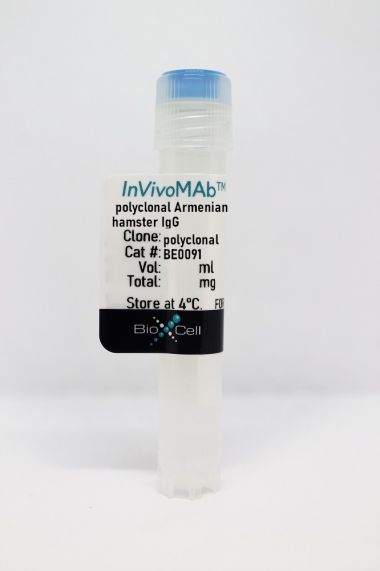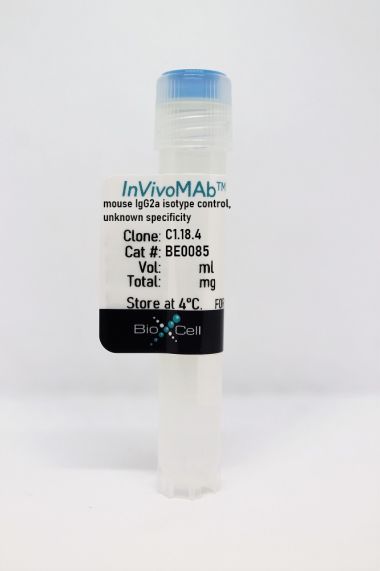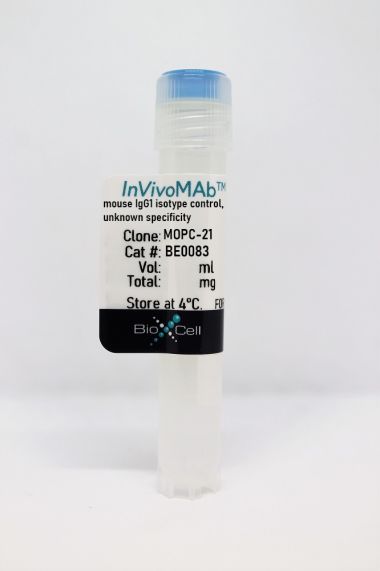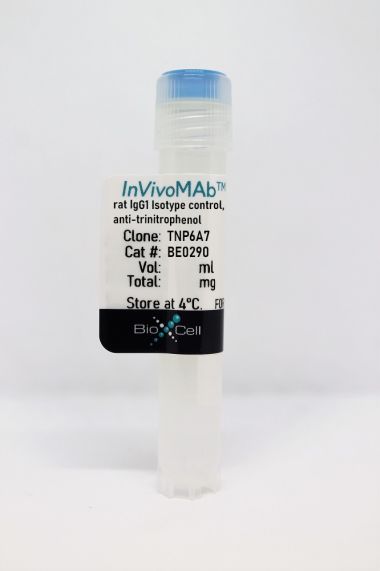InVivoPlus mouse IgG2b isotype control, unknown specificity
Product Details
The MPC-11 monoclonal antibody is ideal for use as a non-reactive isotype-matched control for mouse IgG2b antibodies in most in vivo and in vitro applications.Specifications
| Isotype | Mouse IgG2b, κ |
|---|---|
| Recommended Dilution Buffer | InVivoPure pH 7.0 Dilution Buffer |
| Conjugation | This product is unconjugated. Conjugation is available via our Antibody Conjugation Services. |
| Formulation |
PBS, pH 7.0 Contains no stabilizers or preservatives |
| Aggregation* |
<5% Determined by SEC |
| Purity |
>95% Determined by SDS-PAGE |
| Sterility | 0.2 µm filtration |
| Production | Purified from cell culture supernatant in an animal-free facility |
| Purification | Protein G |
| RRID | AB_1107791 |
| Molecular Weight | 150 kDa |
| Murine Pathogen Tests* |
Ectromelia/Mousepox Virus: Negative Hantavirus: Negative K Virus: Negative Lactate Dehydrogenase-Elevating Virus: Negative Lymphocytic Choriomeningitis virus: Negative Mouse Adenovirus: Negative Mouse Cytomegalovirus: Negative Mouse Hepatitis Virus: Negative Mouse Minute Virus: Negative Mouse Norovirus: Negative Mouse Parvovirus: Negative Mouse Rotavirus: Negative Mycoplasma Pulmonis: Negative Pneumonia Virus of Mice: Negative Polyoma Virus: Negative Reovirus Screen: Negative Sendai Virus: Negative Theiler’s Murine Encephalomyelitis: Negative |
| Storage | The antibody solution should be stored at the stock concentration at 4°C. Do not freeze. |
Additional Formats
Recommended Products
Turnis, M. E., et al. (2016). "Interleukin-35 Limits Anti-Tumor Immunity" Immunity 44(2): 316-329. PubMed
Regulatory T (Treg) cells pose a major barrier to effective anti-tumor immunity. Although Treg cell depletion enhances tumor rejection, the ensuing autoimmune sequelae limits its utility in the clinic and highlights the need for limiting Treg cell activity within the tumor microenvironment. Interleukin-35 (IL-35) is a Treg cell-secreted cytokine that inhibits T cell proliferation and function. Using an IL-35 reporter mouse, we observed substantial enrichment of IL-35(+) Treg cells in tumors. Neutralization with an IL-35-specific antibody or Treg cell-restricted deletion of IL-35 production limited tumor growth in multiple murine models of human cancer. Limiting intratumoral IL-35 enhanced T cell proliferation, effector function, antigen-specific responses, and long-term T cell memory. Treg cell-derived IL-35 promoted the expression of multiple inhibitory receptors (PD1, TIM3, LAG3), thereby facilitating intratumoral T cell exhaustion. These findings reveal previously unappreciated roles for IL-35 in limiting anti-tumor immunity and contributing to T cell dysfunction in the tumor microenvironment.
Barreira da Silva, R., et al. (2015). "Dipeptidylpeptidase 4 inhibition enhances lymphocyte trafficking, improving both naturally occurring tumor immunity and immunotherapy" Nat Immunol 16(8): 850-858. PubMed
The success of antitumor immune responses depends on the infiltration of solid tumors by effector T cells, a process guided by chemokines. Here we show that in vivo post-translational processing of chemokines by dipeptidylpeptidase 4 (DPP4, also known as CD26) limits lymphocyte migration to sites of inflammation and tumors. Inhibition of DPP4 enzymatic activity enhanced tumor rejection by preserving biologically active CXCL10 and increasing trafficking into the tumor by lymphocytes expressing the counter-receptor CXCR3. Furthermore, DPP4 inhibition improved adjuvant-based immunotherapy, adoptive T cell transfer and checkpoint blockade. These findings provide direct in vivo evidence for control of lymphocyte trafficking via CXCL10 cleavage and support the use of DPP4 inhibitors for stabilizing biologically active forms of chemokines as a strategy to enhance tumor immunotherapy.
Le Saout, C., et al. (2014). "Chronic exposure to type-I IFN under lymphopenic conditions alters CD4 T cell homeostasis" PLoS Pathog 10(3): e1003976. PubMed
HIV infection and the associated chronic immune activation alter T cell homeostasis leading to CD4 T cell depletion and CD8 T cell expansion. The mechanisms behind these outcomes are not totally defined and only partially explained by the direct cytopathic effect of the virus. In this manuscript, we addressed the impact of lymphopenia and chronic exposure to IFN-alpha on T cell homeostasis. In a lymphopenic murine model, this interaction led to decreased CD4 counts and CD8 T cell expansion in association with an increase in the Signal Transducer and Activator of Transcription 1 (STAT1) levels resulting in enhanced CD4 T cell responsiveness to IFN-alpha. Thus, in the setting of HIV infection, chronic stimulation of this pathway could be detrimental for CD4 T cell homeostasis.
Larena, M., et al. (2011). "Pivotal role of antibody and subsidiary contribution of CD8+ T cells to recovery from infection in a murine model of Japanese encephalitis" J Virol 85(11): 5446-5455. PubMed
The immunological correlates for recovery from primary Japanese encephalitis virus (JEV) infection in humans and experimental animals remain poorly defined. To investigate the relative importance of the adaptive immune responses, we have established a mouse model for Japanese encephalitis in which a low-dose virus inoculum was administered into the footpads of adult C57BL/6 mice. In this model, ~60% of the mice developed a fatal encephalitis and a virus burden in the central nervous system (CNS). Using mice lacking B cells (muMT(-/-) mice) and immune B cell transfer to wild-type mice, we show a critically important role for humoral immunity in preventing virus spread to the CNS. T cell help played an essential part in the maintenance of an effective antibody response necessary to combat the infection, since mice lacking major histocompatibility complex class II showed truncated IgM and blunted IgG responses and uniformly high lethality. JEV infection resulted in extensive CD8(+) T cell activation, judged by upregulation of surface markers CD69 and CD25 and cytokine production after stimulation with a JEV NS4B protein-derived H-2D(b)-binding peptide and trafficking of virus-immune CD8(+) T cells into the CNS. However, no significant effect of CD8(+) T cells on the survival phenotype was found, which was corroborated in knockout mice lacking key effector molecules (Fas receptor, perforin, or granzymes) of cytolytic pathways triggered by T lymphocytes. Accordingly, CD8(+) T cells are mostly dispensable for recovery from infection with JEV. This finding highlights the conflicting role that CD8(+) T cells play in the pathogenesis of JEV and closely related encephalitic flaviviruses such as West Nile virus.
Lamere, M. W., et al. (2011). "Regulation of antinucleoprotein IgG by systemic vaccination and its effect on influenza virus clearance" J Virol 85(10): 5027-5035. PubMed
Seasonal influenza epidemics recur due to antigenic drift of envelope glycoprotein antigens and immune evasion of circulating viruses. Additionally, antigenic shift can lead to influenza pandemics. Thus, a universal vaccine that protects against multiple influenza virus strains could alleviate the continuing impact of this virus on human health. In mice, accelerated clearance of a new viral strain (cross-protection) can be elicited by prior infection (heterosubtypic immunity) or by immunization with the highly conserved internal nucleoprotein (NP). Both heterosubtypic immunity and NP-immune protection require antibody production. Here, we show that systemic immunization with NP readily accelerated clearance of a 2009 pandemic H1N1 influenza virus isolate in an antibody-dependent manner. However, human immunization with trivalent inactivated influenza virus vaccine (TIV) only rarely and modestly boosted existing levels of anti-NP IgG. Similar results were observed in mice, although the reaction could be enhanced with adjuvants, by adjusting the stoichiometry among NP and other vaccine components, and by increasing the interval between TIV prime and boost. Importantly, mouse heterosubtypic immunity that had waned over several months could be enhanced by injecting purified anti-NP IgG or by boosting with NP protein, correlating with a long-lived increase in anti-NP antibody titers. Thus, current immunization strategies poorly induce NP-immune antibody that is nonetheless capable of contributing to long-lived cross-protection. The high conservation of NP antigen and the known longevity of antibody responses suggest that the antiviral activity of anti-NP IgG may provide a critically needed component of a universal influenza vaccine.
- Mus musculus (House mouse),
- Immunology and Microbiology
Immune checkpoint activity regulates polycystic kidney disease progression.
In JCI Insight on 22 June 2023 by Kleczko, E. K., Nguyen, D. T., et al.
PubMed
Innate and adaptive immune cells modulate the severity of autosomal dominant polycystic kidney disease (ADPKD), a common kidney disease with inadequate treatment options. ADPKD has parallels with cancer, in which immune checkpoint inhibitors have been shown to reactivate CD8+ T cells and slow tumor growth. We have previously shown that in PKD, CD8+ T cell loss worsens disease. This study used orthologous early-onset and adult-onset ADPKD models (Pkd1 p.R3277C) to evaluate the role of immune checkpoints in PKD. Flow cytometry of kidney cells showed increased levels of programmed cell death protein 1 (PD-1)/cytotoxic T lymphocyte associated protein 4 (CTLA-4) on T cells and programmed cell death ligand 1 (PD-L1)/CD80 on macrophages and epithelial cells in Pkd1RC/RC mice versus WT, paralleling disease severity. PD-L1/CD80 was also upregulated in ADPKD human cells and patient kidney tissue versus controls. Genetic PD-L1 loss or treatment with an anti-PD-1 antibody did not impact PKD severity in early-onset or adult-onset ADPKD models. However, treatment with anti-PD-1 plus anti-CTLA-4, blocking 2 immune checkpoints, improved PKD outcomes in adult-onset ADPKD mice; neither monotherapy altered PKD severity. Combination therapy resulted in increased kidney CD8+ T cell numbers/activation and decreased kidney regulatory T cell numbers correlative with PKD severity. Together, our data suggest that immune checkpoint activation is an important feature of and potential novel therapeutic target in ADPKD.
Skin basal cell carcinomas assemble a pro-tumorigenic spatially organized and self-propagating Trem2+ myeloid niche.
In Nature Communications on 10 May 2023 by Haensel, D., Daniel, B., et al.
PubMed
Cancer immunotherapies have revolutionized treatment but have shown limited success as single-agent therapies highlighting the need to understand the origin, assembly, and dynamics of heterogeneous tumor immune niches. Here, we use single-cell and imaging-based spatial analysis to elucidate three microenvironmental neighborhoods surrounding the heterogeneous basal cell carcinoma tumor epithelia. Within the highly proliferative neighborhood, we find that TREM2+ skin cancer-associated macrophages (SCAMs) support the proliferation of a distinct tumor epithelial population through an immunosuppression-independent manner via oncostatin-M/JAK-STAT3 signaling. SCAMs represent a unique tumor-specific TREM2+ population defined by VCAM1 surface expression that is not found in normal homeostatic skin or during wound healing. Furthermore, SCAMs actively proliferate and self-propagate through multiple serial tumor passages, indicating long-term potential. The tumor rapidly drives SCAM differentiation, with intratumoral injections sufficient to instruct naive bone marrow-derived monocytes to polarize within days. This work provides mechanistic insights into direct tumor-immune niche dynamics independent of immunosuppression, providing the basis for potential combination tumor therapies. © 2023. The Author(s).
- In Vivo,
- Mus musculus (House mouse),
- Immunology and Microbiology
Conditional PD-1/PD-L1 Probody Therapeutics Induce Comparable Antitumor Immunity but Reduced Systemic Toxicity Compared with Traditional Anti-PD-1/PD-L1 Agents.
In Cancer Immunology Research on 1 December 2021 by Assi, H. H., Wong, C., et al.
PubMed
Immune-checkpoint blockade has revolutionized cancer treatment. However, most patients do not respond to single-agent therapy. Combining checkpoint inhibitors with other immune-stimulating agents increases both efficacy and toxicity due to systemic T-cell activation. Protease-activatable antibody prodrugs, known as Probody therapeutics (Pb-Tx), localize antibody activity by attenuating capacity to bind antigen until protease activation in the tumor microenvironment. Herein, we show that systemic administration of anti-programmed cell death ligand 1 (anti-PD-L1) and anti-programmed cell death protein 1 (anti-PD-1) Pb-Tx to tumor-bearing mice elicited antitumor activity similar to that of traditional PD-1/PD-L1-targeted antibodies. Pb-Tx exhibited reduced systemic activity and an improved nonclinical safety profile, with markedly reduced target occupancy on peripheral T cells and reduced incidence of early-onset autoimmune diabetes in nonobese diabetic mice. Our results confirm that localized PD-1/PD-L1 inhibition by Pb-Tx can elicit robust antitumor immunity and minimize systemic immune-mediated toxicity. These data provide further preclinical rationale to support the ongoing development of the anti-PD-L1 Pb-Tx CX-072, which is currently in clinical trials.©2021 The Authors; Published by the American Association for Cancer Research.
- Cancer Research,
- Immunology and Microbiology
Myeloid cell subsets that express latency-associated peptide promote cancer growth by modulating T cells.
In IScience on 19 November 2021 by Gabriely, G., Ma, D., et al.
PubMed
Myeloid suppressor cells promote tumor growth by a variety of mechanisms which are not fully characterized. We identified myeloid cells (MCs) expressing the latency-associated peptide (LAP) of TGF-β on their surface and LAPHi MCs that stimulate Foxp3+ Tregs while inhibiting effector T cell proliferation and function. Blocking TGF-β inhibits the tolerogenic ability of LAPHi MCs. Furthermore, adoptive transfer of LAPHi MCs promotes Treg accumulation and tumor growth in vivo. Conversely, anti-LAP antibody, which reduces LAPHi MCs, slows cancer progression. Single-cell RNA-Seq analysis on tumor-derived immune cells revealed LAPHi dominated cell subsets with distinct immunosuppressive signatures, including those with high levels of MHCII and PD-L1 genes. Analogous to mice, LAP is expressed on myeloid suppressor cells in humans, and these cells are increased in glioma patients. Thus, our results identify a previously unknown function by which LAPHi MCs promote tumor growth and offer therapeutic intervention to target these cells in cancer.© 2021 The Authors.
- Biochemistry and Molecular biology,
- Cancer Research,
- Immunology and Microbiology,
- In Vivo,
- Mus musculus (House mouse)
Energy status dictates PD-L1 protein abundance and anti-tumor immunity to enable checkpoint blockade.
In Molecular Cell on 3 June 2021 by Dai, X., Bu, X., et al.
PubMed
Aberrant energy status contributes to multiple metabolic diseases, including obesity, diabetes, and cancer, but the underlying mechanism remains elusive. Here, we report that ketogenic-diet-induced changes in energy status enhance the efficacy of anti-CTLA-4 immunotherapy by decreasing PD-L1 protein levels and increasing expression of type-I interferon (IFN) and antigen presentation genes. Mechanistically, energy deprivation activates AMP-activated protein kinase (AMPK), which in turn, phosphorylates PD-L1 on Ser283, thereby disrupting its interaction with CMTM4 and subsequently triggering PD-L1 degradation. In addition, AMPK phosphorylates EZH2, which disrupts PRC2 function, leading to enhanced IFNs and antigen presentation gene expression. Through these mechanisms, AMPK agonists or ketogenic diets enhance the efficacy of anti-CTLA-4 immunotherapy and improve the overall survival rate in syngeneic mouse tumor models. Our findings reveal a pivotal role for AMPK in regulating the immune response to immune-checkpoint blockade and advocate for combining ketogenic diets or AMPK agonists with anti-CTLA4 immunotherapy to combat cancer. Copyright © 2021 Elsevier Inc. All rights reserved.
- Cancer Research,
- Immunology and Microbiology
Cytotoxic lymphocytes target characteristic biophysical vulnerabilities in cancer.
In Immunity on 11 May 2021 by Tello-Lafoz, M., Srpan, K., et al.
PubMed
Immune cells identify and destroy tumors by recognizing cellular traits indicative of oncogenic transformation. In this study, we found that myocardin-related transcription factors (MRTFs), which promote migration and metastatic invasion, also sensitize cancer cells to the immune system. Melanoma and breast cancer cells with high MRTF expression were selectively eliminated by cytotoxic lymphocytes in mouse models of metastasis. This immunosurveillance phenotype was further enhanced by treatment with immune checkpoint blockade (ICB) antibodies. We also observed that high MRTF signaling in human melanoma is associated with ICB efficacy in patients. Using biophysical and functional assays, we showed that MRTF overexpression rigidified the filamentous actin cytoskeleton and that this mechanical change rendered mouse and human cancer cells more vulnerable to cytotoxic T lymphocytes and natural killer cells. Collectively, these results suggest that immunosurveillance has a mechanical dimension, which we call mechanosurveillance, that is particularly relevant for the targeting of metastatic disease. Copyright © 2021 Elsevier Inc. All rights reserved.
- In Vivo,
- Mus musculus (House mouse),
- Biochemistry and Molecular biology,
- Genetics,
- Immunology and Microbiology
DNA scaffolds enable efficient and tunable functionalization of biomaterials for immune cell modulation.
In Nature Nanotechnology on 1 February 2021 by Huang, X., Williams, J. Z., et al.
PubMed
Biomaterials can improve the safety and presentation of therapeutic agents for effective immunotherapy, and a high level of control over surface functionalization is essential for immune cell modulation. Here, we developed biocompatible immune cell-engaging particles (ICEp) that use synthetic short DNA as scaffolds for efficient and tunable protein loading. To improve the safety of chimeric antigen receptor (CAR) T cell therapies, micrometre-sized ICEp were injected intratumorally to present a priming signal for systemically administered AND-gate CAR-T cells. Locally retained ICEp presenting a high density of priming antigens activated CAR T cells, driving local tumour clearance while sparing uninjected tumours in immunodeficient mice. The ratiometric control of costimulatory ligands (anti-CD3 and anti-CD28 antibodies) and the surface presentation of a cytokine (IL-2) on ICEp were shown to substantially impact human primary T cell activation phenotypes. This modular and versatile biomaterial functionalization platform can provide new opportunities for immunotherapies.
- Cancer Research,
- Immunology and Microbiology
Multimodel preclinical platform predicts clinical response of melanoma to immunotherapy.
In Nature Medicine on 1 May 2020 by Pérez-Guijarro, E., Yang, H. H., et al.
PubMed
Although immunotherapy has revolutionized cancer treatment, only a subset of patients demonstrate durable clinical benefit. Definitive predictive biomarkers and targets to overcome resistance remain unidentified, underscoring the urgency to develop reliable immunocompetent models for mechanistic assessment. Here we characterize a panel of syngeneic mouse models, representing a variety of molecular and phenotypic subtypes of human melanomas and exhibiting their diverse range of responses to immune checkpoint blockade (ICB). Comparative analysis of genomic, transcriptomic and tumor-infiltrating immune cell profiles demonstrated alignment with clinical observations and validated the correlation of T cell dysfunction and exclusion programs with resistance. Notably, genome-wide expression analysis uncovered a melanocytic plasticity signature predictive of patient outcome in response to ICB, suggesting that the multipotency and differentiation status of melanoma can determine ICB benefit. Our comparative preclinical platform recapitulates melanoma clinical behavior and can be employed to identify mechanisms and treatment strategies to improve patient care.
- Mus musculus (House mouse),
- Immunology and Microbiology,
- Neuroscience
Pre-clinical characterisation of E2814, a high-affinity antibody targeting the microtubule-binding repeat domain of tau for passive immunotherapy in Alzheimer's disease.
In Acta Neuropathologica Communications on 4 February 2020 by Roberts, M., Sevastou, I., et al.
PubMed
Tau deposition in the brain is a pathological hallmark of many neurodegenerative disorders, including Alzheimer's disease (AD). During the course of these tauopathies, tau spreads throughout the brain via synaptically-connected pathways. Such propagation of pathology is thought to be mediated by tau species ("seeds") containing the microtubule binding region (MTBR) composed of either three repeat (3R) or four repeat (4R) isoforms. The tau MTBR also forms the core of the neuropathological filaments identified in AD brain and other tauopathies. Multiple approaches are being taken to limit tau pathology, including immunotherapy with anti-tau antibodies. Given its key structural role within fibrils, specifically targetting the MTBR with a therapeutic antibody to inhibit tau seeding and aggregation may be a promising strategy to provide disease-modifying treatment for AD and other tauopathies. Therefore, a monoclonal antibody generating campaign was initiated with focus on the MTBR. Herein we describe the pre-clinical generation and characterisation of E2814, a humanised, high affinity, IgG1 antibody recognising the tau MTBR. E2814 and its murine precursor, 7G6, as revealed by epitope mapping, are antibodies bi-epitopic for 4R and mono-epitopic for 3R tau isoforms because they bind to sequence motif HVPGG. Functionally, both antibodies inhibited tau aggregation in vitro. They also immunodepleted a variety of MTBR-containing tau protein species. In an in vivo model of tau seeding and transmission, attenuation of deposition of sarkosyl-insoluble tau in brain could also be observed in response to antibody treatment. In AD brain, E2814 bound different types of tau filaments as shown by immunogold labelling and recognised pathological tau structures by immunohistochemical staining. Tau fragments containing HVPGG epitopes were also found to be elevated in AD brain compared to PSP or control. Taken together, the data reported here have led to E2814 being proposed for clinical development.
- Mus musculus (House mouse),
- Cancer Research,
- Immunology and Microbiology
Dual-mechanism based CTLs infiltration enhancement initiated by Nano-sapper potentiates immunotherapy against immune-excluded tumors.
In Nature Communications on 30 January 2020 by Huang, Y., Chen, Y., et al.
PubMed
The failure of immunotherapies in immune-excluded tumor (IET) is largely ascribed to the void of intratumoral cytotoxic T cells (CTLs). The major obstacles are the excessive stroma, defective vasculatures and the deficiency of signals recruiting CTLs. Here we report a dual-mechanism based CTLs infiltration enhancer, Nano-sapper, which can simultaneously reduce the physical obstacles in tumor microenvironment and recruiting CTLs to potentiate immunotherapy in IET. Nano-sapper consists a core that co-loaded with antifibrotic phosphates-modified α-mangostin and plasmid encoding immune-enhanced cytokine LIGHT. Through reversing the abnormal activated fibroblasts, decreasing collagen deposition, normalizing the intratumoral vasculatures, and in situ stimulating the lymphocyte-recruiting chemoattractants expression, Nano-sapper paves the road for the CTLs infiltration, induces the intratumoral tertiary lymphoid structures, thus reshapes tumor microenvironment and potentiates checkpoint inhibitor against IET. This study demonstrates that the combination of antifibrotic agent and immune-enhanced cytokine might represent a modality in promoting immunotherapy against IET.
- Cancer Research,
- Immunology and Microbiology
Multi-model preclinical platform predicts clinical response of melanoma to immunotherapy
Preprint on BioRxiv : the Preprint Server for Biology on 6 August 2019 by Pérez-Guijarro, E., Yang, H. H., et al.
PubMed
Although immunotherapy has revolutionized cancer treatment, only a subset of patients demonstrates durable clinical benefit. Definitive predictive biomarkers and targets to overcome resistance remain unidentified, underscoring the urgency to develop reliable immunocompetent models for mechanistic assessment. Here we characterize a panel of syngeneic mouse models representing the main molecular and phenotypic subtypes of human melanomas and exhibiting their range of responses to immune checkpoint blockade (ICB). Comparative analysis of genomic, transcriptomic and tumor-infiltrating immune cell profiles demonstrated alignment with clinical observations and validated the correlation of T cell dysfunction and exclusion programs with resistance. Notably, genome-wide expression analysis uncovered a melanocytic plasticity signature predictive of patient outcome in response to ICB, suggesting that the multipotency and differentiation status of melanoma can determine ICB benefit. Our comparative preclinical platform recapitulates melanoma clinical behavior and can be employed to identify new mechanisms and treatment strategies to improve patient care.
- Stem Cells and Developmental Biology
A Subset of TREM2+ Dermal Macrophages Secretes Oncostatin M to Maintain Hair Follicle Stem Cell Quiescence and Inhibit Hair Growth.
In Cell Stem Cell on 4 April 2019 by Wang, E. C. E., Dai, Z., et al.
PubMed
Hair growth can be induced from resting mouse hair follicles by topical application of JAK inhibitors, suggesting that JAK-STAT signaling is required for maintaining hair follicle stem cells (HFSCs) in a quiescent state. Here, we show that Oncostatin M (OSM), an IL-6 family cytokine, negatively regulates hair growth by signaling through JAK-STAT5 to maintain HFSC quiescence. Genetic deletion of the OSM receptor or STAT5 can induce premature HFSC activation, suggesting that the resting telogen stage is actively maintained by the hair follicle niche. Single-cell RNA sequencing revealed that the OSM source is not intrinsic to the hair follicle itself and is instead a subset of TREM2+ macrophages that is enriched within the resting follicle and deceases immediately prior to HFSC activation. In vivo inhibition of macrophage function was sufficient to induce HFSC proliferation and hair cycle induction. Together these results clarify how JAK-STAT signaling actively inhibits hair growth.Copyright © 2019. Published by Elsevier Inc.

